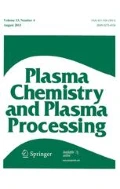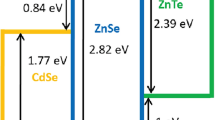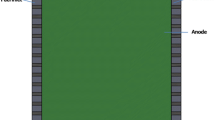Abstract
In recent experiments, it is found that an annular boss anode structure can be used to adjust the arc anode attachment mode, which is expected to be beneficial for improving the anode heat transfer. To understand the effect of annular boss structure on the arc anode attachment, two-dimensional axisymmetric numerical simulation is performed based on a two-temperature chemical non-equilibrium model. The results show that the existence of the annular boss changes the distribution of electric field along the anode surface, and then the arc is attracted to the annular boss because of the enhancement of the nearby electric field intensity. This results in a decrease in the peak current density and a change in its radial distribution in the anode arc attachment region. As a result, the magnitude and direction of the Lorentz force are also changed, acting to suppress the formation of the anode jet. Compared with the case of planar anode, the heat flux of anode with annular boss decreases significantly due to the diffusive arc attachment, which results in significant reduction of the maximum anode temperature. Besides, the effect of the size of annular boss on arc anode attachment behavior has been investigated and the numerical results show that a reasonable choice of inner diameter is important for the formation of diffusion-type anode arc attachment.












Similar content being viewed by others
Data Availability
The data that support the findings of this study are available from the corresponding author upon reasonable request.
References
Murphy AB, Uhrlandt D (2018) Foundations of high-pressure thermal plasmas. Plasma Sources Sci Technol 27(6):063001
Patel AR, Shukla AN (2018) Design & experiments on pen-shaped plasma torch for surface modification. Alex Eng J 57(4):3199–3203
Sanders NA, Pfender E (1984) Measurement of anode falls and anode heat transfer in atmospheric pressure high intensity arcs. J Appl Phys 55(3):714–722
Chen DM, Pfender E (1980) Modeling of the anode contraction region of high intensity arcs. IEEE Trans Plasma Sci 8(3):252–259
Yang G, Heberlein JVR (2007) Anode attachment modes and their formation in a high intensity argon arc. Plasma Sources Sci Technol 16(3):529–542
Mentel J, Heberlein JVR (2010) The anode region of low current arcs in high intensity discharge lamps. J Phys D Appl Phys 43(2):023002
Vardelle A, Moreau C, Akedo J et al (2016) The 2016 Thermal Spray Roadmap. Joutnal of Thermal Spray Technology 25(8):1376–1440
Schein J, Zierhut J, Dzulko M et al (2007) Improved plasma spray torch stability through multi-electrode design. Contrib Plasma Phys 47(7):498–504
Xia WD, Li L, Zhao Y et al (2006) Dynamics of large-scale magnetically rotating arc plasmas. Appl Phys Lett 88(21):211501
Pan WX, Chen LW, Meng X et al (2016) Sufficiently diffused attachment of nitrogen arc by gasdynamic action. Theor Appl Mech Lett 6(6):293–296
Hu YH, Meng X, Huang HJ et al (2021) A novel anode structure for diffuse arc anode attachment. J Phys D Appl Phys. https://doi.org/10.1088/1361-6463/ac0b10
Hsu KC, Etemadi K, Pfender E (1983) Study of the free-burning high-intensity argon arc. J Appl Phys 54(3):1293–1301
Dinulescu HA, Pfender E (1980) Analysis of the anode boundary layer of high intensity arcs. J Appl Phys 51(6):3149–3157
Heberlein JVR, Mentel J, Pfender E (2009) The anode region of electric arcs: a survey. J Phys D Appl Phys 43(2):023001
Chen DM, Pfender E (1981) Two-temperature modeling of the anode contraction region of high-intensity arcs. IEEE Trans Plasma Sci 9(4):265–274
Niu C, Sun SR, Sun JH et al (2021) Numerical simulation of anode heat transfer of nitrogen arc utilizing two-temperature chemical non-equilibrium model. Chin Phys B 30(9):095206
Li HP, Benilov MS (2007) Effect of a near-cathode sheath on heat transfer in high-pressure arc plasmas. J Phys D Appl Phys 40(7):2010–2017
Shkolnik SM (2011) Anode phenomena in arc discharges: a review. Plasma Sources Sci Technol 20(1):013001
Benilov MS, Almeida NA, Baeva M et al (2016) Account of near-cathode sheath in numerical models of high-pressure arc discharges. J Phys D Appl Phys 49(21):215201
Sun JH, Sun SR, Niu C et al (2021) Non-equilibrium modeling on the plasma-electrode interaction in an argon DC plasma torch. J Phys D Appl Phys 54(46):465202
Baeva M, Kozakov R, Gorchakov S et al (2012) Two-temperature chemically non-equilibrium modelling of transferred arcs. Plasma Sources Sci Technol 21(5):055027
Raizer YP (1991) Gas discharge physics. Springer, Berlin, Germany
Jonkers J, Sande MVD, Sola A et al (2003) The role of molecular rare gas ions in plasmas operated at atmospheric pressure. Plasma Sources Sci Technol 12(3):464–474
Cunningham AJ, O’Malley TF, Hobson RM (1981) On the role of vibrational excitation in dissociative recombination. J Phys B: At Mol Opt Phys 14(4):773–782
Bultel A, Ootegem BV, Bourdon A et al (2002) Influence of Ar2+ in an argon collisional-radiative model. Phys Rev E 65(4):046406
Lymberopoulos DP, Economou DJ (1993) Fluid simulations of glow discharges: effect of metastable atoms in argon. J Appl Phys 73(8):3668–3679
Kabouzi Y, Graves DB (2007) Modeling of atmospheric-pressure plasma columns sustained by surface waves. Phys Rev E 75(1):016402
Sun SR, Zhu T, Wang HX et al (2020) Three-dimensional chemical non-equilibrium simulation of an argon transferred arc with cross-flow. J Phys D Appl Phys 53(30):305202
Niu C, Meng X, Huang HJ et al (2021) Numerical simulation of the effects of protrusion on DC arc anode attachment. Plasma Sci Technol 23(10):104006
Sun SR, Wang HX, Zhu T et al (2019) Chemical non-equilibrium simulation of anode attachment of an argon transferred arc. Plasma Chem Plasma Process 40(1):261–282
Sun SR, Wang HX, Zhu T (2020) Numerical analysis of chemical reaction processes in different anode attachments of a high-intensity argon arc. Contrib Plasma Phys 60(3):e201900094
Ramshaw JD (1996) Multicomponent diffusion in two-temperature magneto-hydrodynamics. Phys Rev E 53(6):6382–6388
Ramshaw JD, Chang CH (1991) Ambipolar diffusion in multicomponent plasmas. Plasma Chem Plasma Process 11(3):395–402
Ramshaw JD (1990) Self-consistent effective binary diffusion in multicomponent gas mixtures. J Non-Equilib Thermodyn 15(3):295–300
Fridman A, Cho YI, Greene GA et al (2007) Transport phenomena in plasma: advances in heat transfer. Academic Press, Elsevier, Waltham, MA, USA
Devoto RS (1973) Transport coefficients of ionized argon. Phys Fluids 16(5):616–623
Konishi K, Shigeta M, Tanaka M et al (2017) Numerical study on thermal non-equilibrium of arc plasmas in TIG welding processes using a two-temperature model. Welding in the World 61(1):197–207
Wang HX, Chen SQ, Chen X (2012) Thermodynamic and transport properties of two-temperature lithium plasmas. J Phys D Appl Phys 45(16):165202
Murphy AB, Arundelli CJ (1994) Transport coefficients of argon, nitrogen, oxygen, argon-nitrogen, and argon-oxygen plasmas. Plasma Chem Plasma Process 14(4):451–490
Aziz RA, Slaman MJ (1990) The repulsive wall of the Ar-Ar interatomic potential reexamined. J Chem Phys 92(2):1030–1035
Zhang XN, Li HP, Murphy AB et al (2015) Comparison of the transport properties of two-temperature argon plasmas calculated using different methods. Plasma Sources Sci Technol 24(3):035011
Li HP, Chen X (2001) Three-dimensional modelling of a DC non-transferred arc plasma torch. J Phys D Appl Phys 99(17):L99–L102
Hsu KC (1982) A self-consistent model for the high intensity free-burning argon arc. University of Minnesota, Minnesota
Baeva M (2017) Non-equilibrium modeling of tungsten-inert gas arcs. Plasma Chem Plasma Process 37(2):341–370
Baeva M, Uhrlandt D (2017) Advanced nonequilibrium modelling of dc tungsten-inert gas arcs. Plasma Physics and Technology 4(3):203–212
Baeva M, Benilov MS, Almeida NA et al (2016) Novel non-equilibrium modelling of a DC electric arc in argon. J Phys D Appl Phys 49(24):245205
Acknowledgements
This work was supported by the National Natural Science Foundation of China (Grant Nos. 11735004, 12005010 and 12175011).
Author information
Authors and Affiliations
Corresponding authors
Additional information
Publisher's Note
Springer Nature remains neutral with regard to jurisdictional claims in published maps and institutional affiliations.
Rights and permissions
About this article
Cite this article
Niu, C., Hu, YH., Shao, K. et al. Numerical Simulation of the Effect of Annular Boss Structure on DC Arc Anode Attachment. Plasma Chem Plasma Process 42, 885–904 (2022). https://doi.org/10.1007/s11090-022-10249-z
Received:
Accepted:
Published:
Issue Date:
DOI: https://doi.org/10.1007/s11090-022-10249-z




